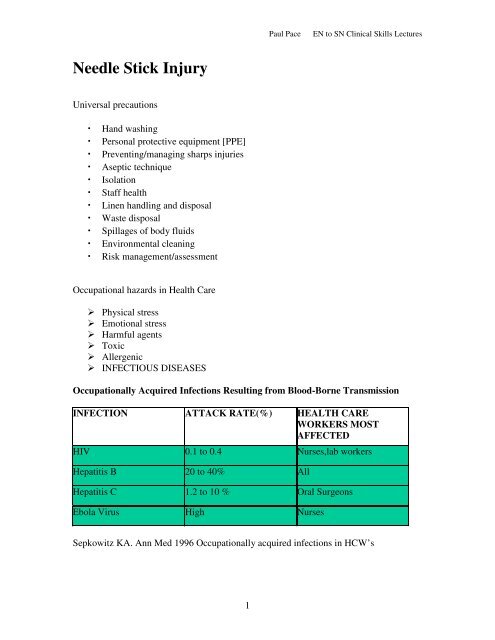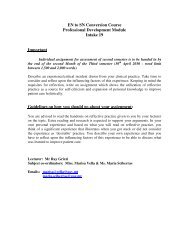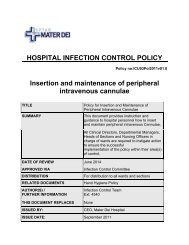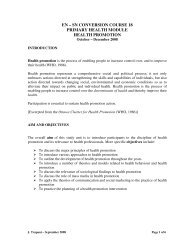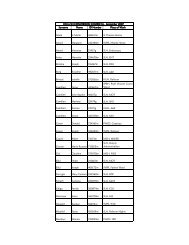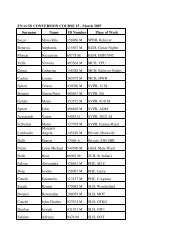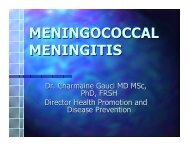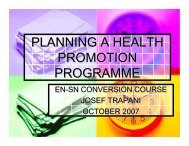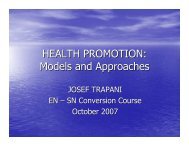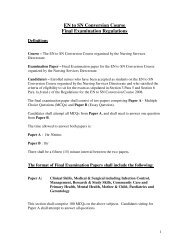Needle Stick Injury
Needle Stick Injury
Needle Stick Injury
Create successful ePaper yourself
Turn your PDF publications into a flip-book with our unique Google optimized e-Paper software.
<strong>Needle</strong> <strong>Stick</strong> <strong>Injury</strong><br />
Universal precautions<br />
• Hand washing<br />
• Personal protective equipment [PPE]<br />
• Preventing/managing sharps injuries<br />
• Aseptic technique<br />
• Isolation<br />
• Staff health<br />
• Linen handling and disposal<br />
• Waste disposal<br />
• Spillages of body fluids<br />
• Environmental cleaning<br />
• Risk management/assessment<br />
Occupational hazards in Health Care<br />
Physical stress<br />
Emotional stress<br />
Harmful agents<br />
Toxic<br />
Allergenic<br />
INFECTIOUS DISEASES<br />
1<br />
Paul Pace EN to SN Clinical Skills Lectures<br />
Occupationally Acquired Infections Resulting from Blood-Borne Transmission<br />
INFECTION ATTACK RATE(%) HEALTH CARE<br />
WORKERS MOST<br />
AFFECTED<br />
HIV 0.1 to 0.4 Nurses,lab workers<br />
Hepatitis B 20 to 40% All<br />
Hepatitis C 1.2 to 10 % Oral Surgeons<br />
Ebola Virus High Nurses<br />
Sepkowitz KA. Ann Med 1996 Occupationally acquired infections in HCW’s
2<br />
Paul Pace EN to SN Clinical Skills Lectures<br />
Occupationally Acquired Infections Resulting from Airborne Transmission<br />
INFECTION ATTACK RATE(%) HEALTH CARE<br />
WORKERS MOST<br />
AFFECTED<br />
Tuberculosis 20 to 50 All<br />
Varicella 4.4 to 14.5 All<br />
Influenza 3.8 to 45 Nurses,Doctors<br />
Rubella 13 All<br />
Pertussis 43 All<br />
Parvovirus 27 to 47 Nurses<br />
RSV 42 to 56 All<br />
Adenovirus 22 to 39 ITU’s,Ophthalmic<br />
Clinics<br />
Sepkowitz KA. Ann Med 1996 Occupationally acquired infections in HCW’s<br />
Infections transmitted by blood and body fluids<br />
Hepatitis B<br />
HIV<br />
Hepatitis C<br />
Occupational Risk of Hepatitis B<br />
• Much more transmissible than HIV<br />
• Risk after needle stick: 2% - 40%<br />
• 1994 - 1000 health care workers developed HBV infection<br />
• Approximately 200 HCWs die each year<br />
Source: CDC, 1991; 1997
Occupational Risk of Hepatitis C<br />
3<br />
Paul Pace EN to SN Clinical Skills Lectures<br />
• HCV - major cause of chronic liver disease<br />
• No vaccine<br />
• No effective post-exposure prophylaxis<br />
• 85% of HCV infected people develop chronic infection Source: CDC, 1997; NIH, 1997<br />
Occupational Risk of HIV<br />
• Risk after needle stick - 1 in 300<br />
• Exposures from needle sticks or cuts cause most infections<br />
VACCINATION<br />
Vaccine recommendations<br />
Hepatitis B Immunisation<br />
Dose 1<br />
Dose 2 1 month after first dose<br />
Dose 3 5 months after second dose<br />
Anti-bodies are checked after 8 weeks<br />
Post Vaccination Management<br />
Source: CDC, 1991; 1996
1). Always avoid re-capping.<br />
Sharp Containers<br />
<strong>Needle</strong> <strong>Stick</strong> Injuries<br />
2). Never hand over used needles to other colleagues.<br />
3). Never walk about with used needles in your hand.<br />
4<br />
Paul Pace EN to SN Clinical Skills Lectures<br />
4). Make use of the V-shaped mechanism to dislodge needles from syringes.<br />
5). Seal container when 3/4 full.<br />
6). Sharps: <strong>Needle</strong>s, Phials, Introduces and Blades.<br />
7). Read thoroughly the <strong>Needle</strong> <strong>Stick</strong> Injure Policy in your ward.<br />
In case of a needle stick injury:<br />
I. Encourage bleeding.<br />
II. Wash the contaminated site thoroughly with soap and running water.<br />
III. Report any needle stick injures to the<br />
Infection Control Unit.<br />
Do not put your hands or fingers in the sharp containers or try to push sharps down<br />
into a full container.<br />
Empty when the container is ¾ full
5<br />
Paul Pace EN to SN Clinical Skills Lectures<br />
800,000 <strong>Needle</strong>stick Injuries Occur Each Year in the United States<br />
16,000 of These Are Likely to Be Contaminated by HIV<br />
Up to 80% of All Accident Exposures to Blood Are Caused by <strong>Needle</strong>stick Injuries<br />
HCWs with Occupationally Acquired HIV/AIDS Infection<br />
Source: CDC, 1997
Preventable Exposures to Blood/Body Fluids<br />
Description of exposure Number of workers (%)<br />
Recapping a used needle 38 26%<br />
Improper disposal of a used<br />
needle<br />
6<br />
Paul Pace EN to SN Clinical Skills Lectures<br />
94 64%<br />
Skin contact 14 9%<br />
TOTAL 146 100%<br />
As of 1 January, 1997 to August, 2000 at St.Luke’s Hospital


